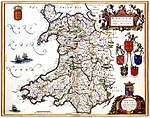Cambro-Normans
Cambro-Normans (Latin: Cambria; "Wales", Welsh: Normans Cymreig) were Anglo-Normans who settled in southern Wales after the Norman conquest of England in 1066. Some Irish historians prefer to use this term instead of Anglo-Norman because many of the Anglo-Norman knights who invaded Ireland in 1170 originated in modern-day Wales.[1] However, south Wales was under English control at this point in history and the Anglo-Normans living in south Wales owed their allegiance to the king of England, not a native Welsh prince. Contemporary Irish accounts of this period simply called the incomers Saxain, which means "Saxon", i.e. "English".[2]
Part of a series on the |
|---|
| History of Wales |
 |
|
Chronology |
|
|
The term Cambro-Norman is rarely used even in Ireland. The Normans who invaded Ireland are commonly described as Anglo-Normans by modern historians or else simply as English. This latter term along with Saxain ("Saxons") was used by contemporary chroniclers in strong preference to Normans.
Richard de Clare, better known as Strongbow, has been described by some Irish historians as a Cambro-Norman rather than an Anglo-Norman. The de Clares held lands in Pembrokeshire and Glamorgan, but their base was in Chepstow, which, although is now a border settlement in Wales, was part of the English county of Herefordshire at the time. Strongbow also held lands in Gloucestershire, Hertfordshire and Suffolk. Herefordshire is in the Welsh Marches, of which Strongbow was a Marcher Lord. He is believed to have retreated to his English holdings when the Welsh began to attack his territory in Netherwent. Strongbow was living in England when he was contacted by Diarmaid MacMurrough, the king of Leinster.
In addition to such Cambro-Norman lords, some of Ireland's most common names, including Walsh and Griffith, came from indigenous Welsh families who came with the Norman invasion. (The surname "Walsh" itself, or in Irish Breathnach, "Briton", means "Welshman", and was applied by the Irish to Welsh who didn't have a surname, as well as to particular Cambro-Norman lords). Other indigenous Welsh surnames, such as Taaffe which came at this time, became very important families within the Pale.
Probably the best known Cambro-Norman surname, also called Hiberno-Norman, is Costello (see also Gilbert de Angulo). Other Cambro-Norman families include the Butlers, the Joyces[3][4][5] and the Barretts.
References
- Bradley, John; Francis X. Martin (1988). Settlement and society in medieval Ireland: studies presented to F.X. Martin. Studies in Irish archaeology and history. 2 of Irish studies. Boethius Press. p. 193. ISBN 978-0-86314-143-0. Retrieved 11 July 2009.
- Flanagan, M.T. (2005), "Anglo-Norman Invasion", in Duffy, S.; MacShamhráin, A.; Moynes, J. (eds.), Medieval Ireland: An Encyclopedia, New York: Routledge, pp. 17–19, ISBN 0-415-94052-4
- Bishop, Alan. 'Gentleman Rider: A Life of Joyce Cary'. Joseph, 1988. Original from the University of Michigan. ISBN 0718123301, 9780718123307. p. 24
- Names. 1985. Original from the University of California. Digitized 3 September 2011. p. 202.
- Stokes, George Thomas. 'Ireland and the Anglo-Norman Church: A History of Ireland and Irish Christianity from the Anglo-Norman Conquest to the Dawn of the Reformation'. Hodder and Stoughton, 1897. Original from the University of California. p. 334